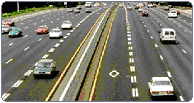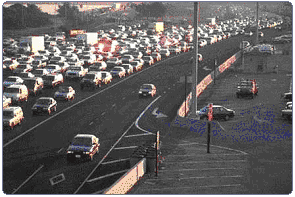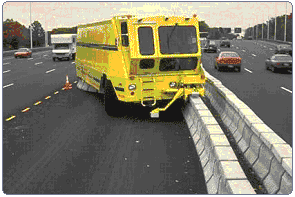
Taxonomy and description
Dahlgren 1994) in the US. They are designed to discourage single/low
occupancy car use by providing additional priority to vehicles with more
than a minimum number of occupants (usually two or three) and buses. They
encourage car sharing and/or public transport use by allowing users to
reduce their journey times relative to single-occupant vehicles, particularly
when the general purpose lanes are congested. This in turn reduces the
number of cars on the network and this reduction in the demand for road
space can reduce overall congestion, fuel consumption and environmental
impacts. They have become much more widespread in the last 10 years in
the USA largely because legislation restricts the construction of mixed
use roads in areas that fail US National Ambient Air Quality Standards.
In Britain, the National Travel Survey shows that between 1997 and 2002,
average car occupancy rate dropped from 1.6 to 1.58, and single car occupancy
is highest for commuting trips (85%). HOV lanes offer potential for making
more efficient use of road space, especially at peak times, by increasing
the attractiveness of public transport and retaining the flexibility and
comfort of the car.
Two-wheel vehicles (motorcycles and/or bicycles) are usually permitted
to use the HOV but this may vary between locations.
An HOV lane can be created in three different ways (ICARO, 1999):
• an existing general purpose lane can be converted into an HOV
lane (temporarily or permanently);
• an additional inside or outside lane can be added ;
• an existing bus way/lane can be converted into an HOV lane.
Such schemes can therefore be considered as either preventing single-occupancy
cars from using all of the available road-space or as providing additional
road capacity for buses and HOVs.
HOV lanes can be a part of motorway (as in the USA) or major arterial
road (as in Leeds, UK). They can be ‘tidal’ to help the traffic
in the busiest direction (usually inbound towards city centres during
the morning peak, outbound during evening peak). They can be permanent
and separated by a physical barrier from the general purpose lanes or
by purely non physical means (lane markings, special traffic signs, etc.
(see illustrations below). The hours and days of HOV lane operation can
vary depending on the congested hours and function of the road stretch
that they are applied e.g. morning peak hours only, on weekdays or at
all times.
In the USA there are now nearly 2,300 miles of HOV lanes

HOV lanes cover 60-mile of the I65/75 in Atlanta (picture above).
There are close to 100 HOV projects on freeways and in separate rights-of-way
in 30 metropolitan areas in North America. A recent list of the HOV lanes
and their details (e.g. length, number of lanes, time of operation) can
be found at the Transportation Research Board: HOV Committee website (available
at http://www.hovworld.com).
A Typical HOV lane in the USA

Changing the direction of a HOV lane

Courtesy of Transportation Research Board (http://www.hovworld.com/photos.html)
Terminology for HOV priority lanes generally also covers bus-only lanes
(bus priority lanes). However, here we restrict attention to dedicated
HOV lanes which both buses and ‘high’ occupancy private vehicles
are allowed to use.
High Occupancy Toll (HOT) lanes are extensions of HOV lanes where ‘low’
occupancy vehicles (LOV) are allowed to use the lane if they pay a toll
(or an increased toll) (Parsons Brinckerhoff, 2003).
Technology
Technology related to the HOV lanes other than the construction of these
lanes is mainly related to its enforcement. It is generally necessary
to allow HOVs to use both general-purpose and HOV lanes and to switch
relatively-freely between them. If the general-purpose lanes are congested
and the HOV relatively free-flowing, there will be temptation for LOV
drivers to violate the HOV lane regulations. The success of the HOV lane
operation therefore depends critically on appropriate enforcement. HOV
lane enforcement involves determining eligibility to use an HOV facility
by observing the number of vehicle occupants and penalising those who
violate it.
Recently, automated occupant observation technologies have been under
investigation. The ENTERPRISE program (see http://enterprise.prog.org)
has been investigating ITS technologies for HOV lane enforcement. Possible
options include outside observation technologies such as digital cameras,
multi-camera video recorders, infrared radar machine vision and automatic
vehicle identification. In the future, there may be some in-vehicle observation
technologies available for HOV lane enforcement, but as yet no wholly-satisfactory
solution has been found.
In the meantime, manual observation of vehicle occupancy will be required.
Where HOV lane is physically separated from other lanes, random police
controls at the entry or exit of the lane is usually relatively straightforward.
Enforcement of HOV lanes with no physical barriers is more difficult.
Alternatives include random checks by the police or other enforcers observing
the use of HOV lanes and/or simply encouraging other drivers to report
HOV lane violators. The latter approach obviously runs into difficulties
if violators chose to simply deny an alleged violation.
Enforcement is crucial for gaining public support for HOV, but providing
manual enforcement is expensive and takes the police away from their core
work, while automated systems are still unproven. In Leeds, the cost of
continuous police enforcement was a factor in the decision to restrict
the lane to peak period operation.

|




